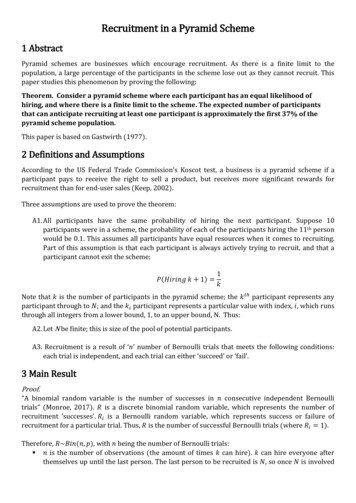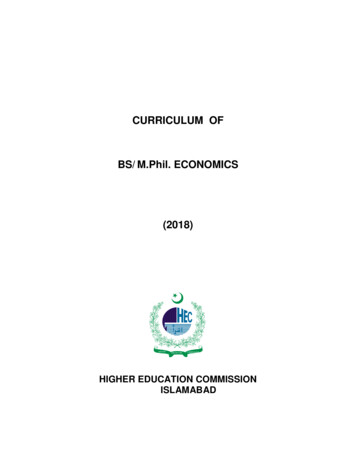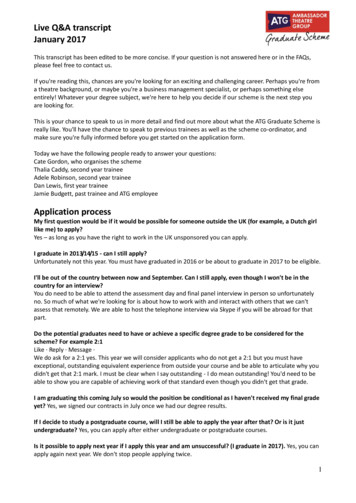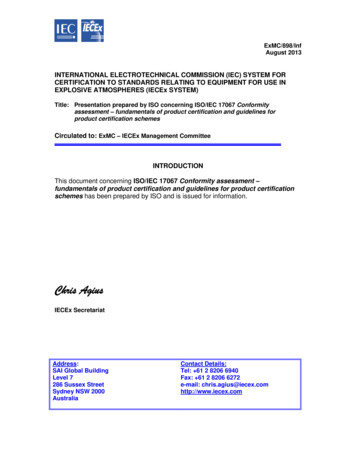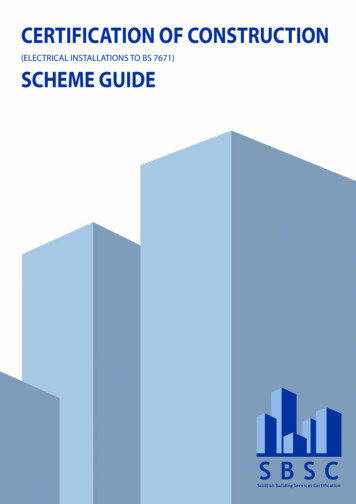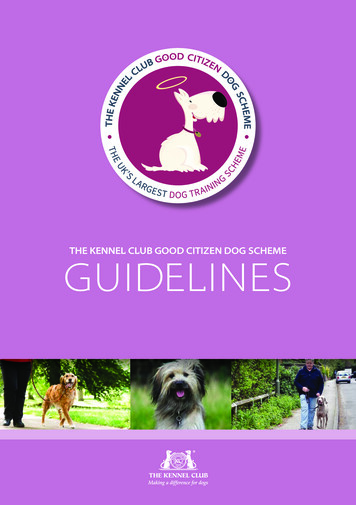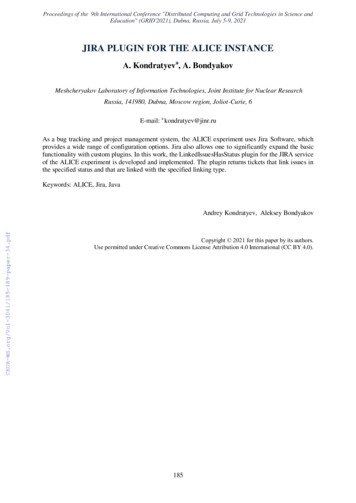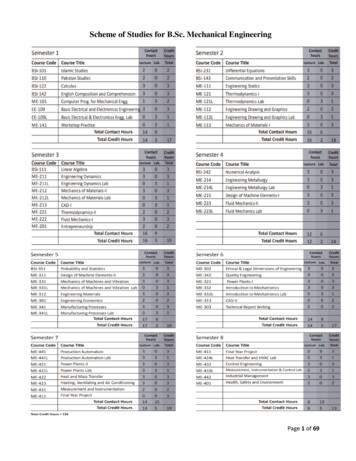
Transcription
Scheme of Studies for B.Sc. Mechanical EngineeringPage 1 of 69
Semester 1No.CourseContact hoursCredithoursLecture Lab.TotalBSI-101Islamic Studies202BSI-110Pakistan Studies202BSI-122Calculus303BSI-142English Composition and Comprehension303ME-101Computer Prog. for Mechanical Engg.132EE-109Basic Electrical and Electronics Engineering303EE-109LBasic Electrical & Electronics Engg. Lab031ME-141Workshop Practice031Total Contact Hours149Total Credit Hours14317Page 2 of 69
SEMESTER 1Course Title: Islamic Studies (2, 0)Course Code: BSI-101Course ContentsBasic Concepts of Islam, Dawat and Seerat un Nabi, Concept of the Holy War in Islam (Jehad). Compilationof the Holy Quran, Basic Concepts of Hadith. Hadith as source of Islamic Law. Tafseer Surah Hujuraat andSurah Noor. Islam as a Complete Code of Life. Human Rights in Islam, and comparative study with otherreligions and Human rights granted by UNO. Quran, Science and Technology, Knowledge and Islam. IslamicCivilization. Woman Rights. Lawful earning. Population Dynamics in Islam.Recommended books:1.2.3.4.5.6.7.8.9.Islamiyat by Mukhtar HassanFamily Planning in Islam by Khalid Saifullah RehmaniFamily Planning by Mufti Muhammad Shafi.A guide book for Muslims by Syed Abul Hasan Ali NadviAn introduction to Islam by Dr. Muhammad Hameed UllahWhat is Islam by Maulana Manzoor Nomani.Islamiat (A Standard Book for CSS), Prof. Dr. Arif Naseem.Islamiat for Students O levels, Farkhanda Noor MuhammadDeenyat by Syed Abul Aala MoudodiCOURSE LEARNING OUTCOMES (CLOs)S. No. CLO Statement1.To understand the basic beliefs of Islam andconcept of Ibadat (worship)2.To know about the Serat-u-Nabi3.To review Islamic civilization and its relevance tocontemporary issuesDomainCognitiveCognitiveCognitiveMappingwith Bloom’sTaxonomyMapping withPLO2PLO-122PLO-84PLO-6Page 3 of 69
Course Title: Pakistan Studies (2, 0)Course Code: BSI-110Course ContentsIdeology, definition, importance some kinds ideology. Pakistan Ideology, Sayings of Quaid-E-Azam, AllamIqbal about Pakistan Ideology, Aims and objectives of the creation of Pakistan. Reformist Movements, ShahWaliullah, Mujadid Alf Sani and Sayyed Ahmad Shaheed. Muslim Nationalism, Partition of Bengal, SimlaDeputation. Muslim League, Lucknow Pact 1916, Khilafat Movement. Nehro Report, Quaid-e-Azam 14points, Iqbal’s Address 1930, Act of 1935, The Congress Ministries. Lahore Resolution 1940, 3rd June andindependence 1947. Constitution in Law, method of making the constitution, the formation of the constituentAssembly 1947, Objective Resolution 1949. Dissolution of the Cabinet of Khwaja Nazimuddin, M.Ali BograFormula 1954 and dissolution of the Constituent Assembly 1954. Decision of Sindh High Court andSupreme Court regarding the dissolution of Assembly in 1955 (Doctrine of Necessity). Features of 1956 and1973 constitutions of Pakistan. Amendments in 1973 Constitution (17th – 20th). Foreign policy of Pakistan,goals and determinants of foreign policy. Population Dynamics in Pakistan. Strategy to control populationgrowth in Pakistan. The role of society and State in controlling population, Socio-economic benefits of birthcontrolling.Recommended books:1.2.3.4.5.6.Struggle for Pakistan by Ishtiaq Hussain QureshiPakistan Studies by Ikram RabbaniPakistan Studies by Javed IqbalConstitutional Development in Pakistan by Safdar Mehmood.Constitutional Development by KB SaeedSocial change by Alama Iqbal University, IslamabadCOURSE LEARNING OUTCOMES (CLOs)S. No. CLO Statement1.2.3.Know about Pakistan’s historical perspective, geostrategic location constitutional phases,contemporary affairs, and future challengesAnalyze major events and lives of prominentpersonalities related to PakistanReview the role of national institutions social issuesincluding population growth in Pakistan, ethnicity,foreign policy and future challengesDomainCognitiveCognitiveMappingwith Bloom’sTaxonomyMapping withPLO2PLO-64PLO-64PLO-6CognitivePage 4 of 69
Course Title: Calculus (3, 0)Course Code: BSI-122Course ContentsMathematical and physical meaning of functions, graphs of various functions, Hyperbolic functions.Theorems of limits and their applications to functions: Some Useful limits, right hand and left hand limits.Continuous and discontinuous functions and their applications. Introduction to derivatives: Geometrical andphysical meaning of derivatives. Product Rules, quotient Rules and different rules of derivative, and itsapplications, problems (rate of change, marginal analysis). Tangent and normal lines, approximation byTaylor and Maclarum serious. Maxima and minima, First and Second derivative test. Integral Calculus, somerules of integrations. Integration by parts, areas bounded by Curve, Volume of Solid of revolution.Multivariable Calculus, Limit continuity of several variables local curve and local surfaces. Partialderivatives, Higher order partial derivatives, total differential, tangent plane, normal lines and itsapplications. Maxima and minima of two variables. Vector functions and its derivatives and its integrations,lines integrals, work done and its applications. Gradient, Divergence, Curve and its applications. Directionalderivatives, solenoidal field, equations of continuity, rotational and irrational fields, scalar potential and itsapplications and fluid dynamics. Method of constraint optimization, Lagrange multiplier method and itsapplications.Recommended books:1. Calculus by Thomas Finney, Addison-Wesley Publishing Company, Latest availableEdition.2. Higher Engineering Mathematics by H.K. Dass and V. Sharma3. Mathematics for Engineer 2nd Edition by Robert Davison, Latest available Edition.4. Multivariate Calculus 2nd Edition by Robert T. Smith, Latest available Edition.COURSE LEARNING OUTCOMES (CLOs)S. No. CLO Statement1.2.To know about different types of functions, theirgraphs, limits, continuities, derivatives andintegrations and to describe the concepts ofDifferential Calculus.To Apply calculus to the problems involving rate ofchange, optimization, area under and between thecurves, volumes, arc length and area of surface ofrevolution etc.DomainCognitiveMappingwith Bloom’sTaxonomyMapping withPLO1PLO-12PLO-2CognitivePage 5 of 69
Course Title: English Composition and Comprehension (3, 0)Course Code: BSI-142Course ContentsWords & expressions commonly misused. Vocabulary Building skills. Introduction to parts of speech indetail. Word formation. Conditional Sentences & types. Tense, voice and narration. Common Grammaticalmistakes. Sentence, its structure, types and kinds. Paragraph, its structure and types. Process of writing.Elementary Principles of Composition and its types. Relative Pronouns & Clauses. Getting the essentialinformation. Order of importance. Critical reading & thinking. Drawing Conclusions; putting it all together.Recommended books:1.2.3.4.5.Writing Effective paragraphs by Howard CJ. Cambridge: Winthrop Publishers, 1976Practical English Usage by Michael Swan. ELBSMichael swan practical English usageThe Little Brown HandbookExploring the world of English by Sadaat Ali ShahCOURSE LEARNING OUTCOMES (CLOs)S. No. CLO StatementDomainMappingwith Bloom’sTaxonomy2PLO-103PLO-101.Practice English correctly in speaking and writing.Affective2.Apply sound vocabulary and skills to use English inprofessional life.CognitiveMapping withPLOPage 6 of 69
Course Title: Computer Programming for Mechanical Engineering (1, 1)Course Code: ME-101Course ContentsTheoryIntroduction to Programming languages and their applications in Mechanical Engineering, C ProgrammingBasics, Data types, Basic Program Structure, Loops and Decisions, Structures and Functions, Objects andClasses, Arrays and Strings, Operators overloading, Inheritance and Pointers, Virtual Functions, Streams andFiles, Multi-file Programs, Templates and Exceptions, The Standard Template Library, Object-OrientedSoftware Development.LaboratoryMs. Office (Word, Excel, Power Point), Introduction to Programming in C , Input/output statements,Conditional Structures, Looping Structures, Arrays, Structures, Functions (Built-in Functions / User-definedFunctions), Pointers, File Handling, Programming for microcontroller for LED (Blinking), program burningto microcontroller IC chip, Introduction to MATLAB, Data Plotting, Differential equations solution, Matricessolution, Engineering equations solution (heat and wave)Recommended books:6. Robert Lafore, Object-Oriented Programming in C , 4th edition, ISBN: 0672323087,SAMS Publishing, 2002.7. John R. Hubbard, Programming with C , 3rd edition, ISBN: 139780070144811, TataMcGraw Hill, 2009.COURSE LEARNING OUTCOMES (CLOs)S. No. CLO StatementDomainMappingwith Bloom’sTaxonomyMapping withPLO1.Understand basic programming structure.Cognitive1PLO-12.Apply learnt skills to solve engineering problem using Cognitivecomputer programming3PLO-5Page 7 of 69
Course Title: Basic Electrical and Electronics Engineering (3,0)Course Code: EE-109Course ContentsIntroduction to Electrical Concepts (Voltage/Current/Power/Power Supplies), DC and AC circuits, DC andAC signals, types of power sources (Constant voltage/Constant current), Ohm’s law and its application,Kirchoff’s Voltage Law (KVL), Kirchoff’s Current Law (KCL), Network analysis (Mesh and Nodal),Network theorems(Thevenin’s / Norton’s/ Superposition and Maximum Power Transfer), Introduction toElectrical Machines,Transformers (Potential Transformer/ Current Transformer/ Auto Transformer), Designand workingof (induction Motors/ Synchronous motors), Introduction to Semiconductor devices (Semiconductors/ Doping/ Fabrication/ P-N junction diodes/ Bipolar junction Transistors(BJTs)/ Field EffectTransistors (FETS) and their applications).Recommended books:1. B.L Theraja, A.K Theraja, Electrical Technology, volume1, ISBN 81-219-2440-5, S.Chand & Company Ltd.2. John O ‘Malley, Theory and Problems of Basic Circuit Analysis, Second Edition, ISBN 007047824-4, Mc Graw-Hill.3. Robert L.Boylested, Louis Nashelsky, K.Lal Kishore, Electronic Devices and CircuitTheory, 9th Edition, ISBN 81-7758-158-9, Pearson Education.COURSE LEARNING OUTCOMES (CLOs)S. No. CLO Statement1.2.3.4.5.DomainExplain with Examples various concepts relatedCognitiveto fundamentals of Electrical EngineeringSolve, Analyze and Evaluate the problems related Cognitiveto Electrical Circuits based on various laws,analysis techniques and theoremsCognitiveExplain the working principles of variousElectrical machines backed by related problemsolvingCognitiveUnderstand, Analyze and Evaluate variousElectronics devices including their fabrication andapplicationsAcquire the basic knowledge related to Electrical Cognitiveand Electronic devicesMappingwith Bloom’sTaxonomyMapping withPLO2PLO-13PLO-22PLO-13PLO-21PLO-1Page 8 of 69
Course Title: Basic Electrical and Electronics Engineering Lab (0, 1)Course Code: EE-109LList of Experiments1. To get familiar with the usage of power supply, voltmeter, ammeter and multimeter.2. To measure the resistance, capacitance, frequency, AC and DC voltage with the help of multimeter.3. To demonstrate a series circuit to measure and calculate its equivalent resistance.4. To demonstrate a parallel circuit to measure and calculate its equivalent resistance.5. To verify KVL6. To verify KCL7. To find turn ratio of a single phase step down transformer.8. To find the turn ration of single phase step up transformer.9. To design and observe the working of a half wave rectifier circuit.10. To design and observe the working of a full wave rectifier circuit.11. To design and observe the working of a Zener voltage regulator circuit.Recommended books:1. Thomas L.Floyd, Electric Circuit Fundamentals, Sixth Edition, ISBN 0-13-111139-6, PearsonEducationCOURSE LEARNING OUTCOMES (CLOs)S. No. CLO Statement1.2.DomainIllustrate knowledge of various laws of ElectricalPsychomotorCircuits, Series and Parallel CircuitShow knowledge of constructing basic electrical/electronic circuits and demonstration of relevant Cognitiveknowledge.Mappingwith Bloom’sTaxonomyMapping withPLO2PLO-13PLO-2Page 9 of 69
Course Title: Engineering Workshops (0,1)Course Code: ME-141List of Experiments1. Introduction to pattern shop tools, machines, and to make bearing bracket.2. Manufacturing of T-Lap Joint, and Dovetail Lap Joint in pattern shop.3. Introduction to lathe machine, tools and to perform plain turning and facing on lathe machine.4. Manufacturing of Job as per drawing from given raw material by performing various operations on lathemachine.5. Manufacturing of bolt on lath machine.6. Shaping a round rod of mild steel into a square by forging method.7. Shaping a round rod of mild steel into wall hook geometry by forging method.8. Making butt, lap, and T-joints by electric arc welding. Joining of metal sheets by spot welding.9. Making butt, lap, and T-joints by Oxy-Acetylene welding. Joining of various electronics components bysoldering method.10. Use of various tools and processes to make a mould.11. Making mould of bearing bracket from green sand and perform casting.12. Use of various tools to perform drilling, reaming, and taping operations.13. Perform measuring, cutting, filling, drilling and reaming operations.14. Introduction to various tools used in making electrical circuits. Making a simple electrical circuit.15. Making a hotel wiring circuit controlled by various switches.Recommended books:1. Krar Steve F., Check Albert F., Machine Tools, 5th edition, ISBN: 0-07-116421-9McGraw-Hill, 1998.COURSE LEARNING OUTCOMES (CLOs)S. No. CLO Statement1.2.3.4.Apply ethical principles while working in thelaboratory and adopt necessary guidelines forstudent’s health & safety.Apply, explain, express and collect informationregarding the course contents and labs.Practice the experimental task and writing skills todevelop an assigned task.Ability to work in a team by participating in groupprojects.DomainMappingwith Bloom’sTaxonomyMapping P3PLO-5AffectiveA2PLO-9Page 10 of 69
Semester 2No.CourseContact hoursCredithoursLecture Lab.TotalBSI-231Differential Equations303BSI-143Communication and Presentation Skills202ME-111Engineering namics Lab031ME-112Engineering Drawing and Graphics202ME-112LEngineering Drawing and Graphics Lab031ME-113Mechanics of Materials-I30316166218Total Contact HoursTotal Credit HoursPage 11 of 69
SEMESTER 2Course Title: Differential Equations (3, 0)Course Code: BSI-231Course ContentsPDE, Linear Differential equations, Non-Linear, Differential equations, Solutions of differential equations,General solutions, Particular solutions, Initial and boundary value problems. Separable equations,Homogeneous equations, Differential equations reducible to homogeneous form and related examples. Exactequations, Integrating factors, Linear equations and related examples. Bernoulli’s equations, orthogonaltrajectories, Equations solvable for p, Equations solvable for y, Equations solvable for x and related examples.Homogeneous linear equations, Differential operators, Non-homogeneous linear equations, Undeterminedcoefficients, Cauchy-Euler equations and related examples. Variation of parameters, exact linear equations,linear system of Differential Equations and related examples. Power series solutions of first order DifferentialEquations, Second order linear equations and related examples. Applications of Ordinary differentialequations in Electrical Engineering. Partial Differential Equations: Method of Separation of variables andrelated examples. Applications of partial differential equations in Engineering.Recommended books:1. Advanced Engineering Mathematics by Erwin Kreyzig, John Wiley & Sons Inc. LatestEdition.2. Differential Equation with Boundary Value problems by D. G. Zill, M. R Cullen LatestEdition, Brook/Cole Publishers.3. Mathematical Methods by Dr. S.M Yousuf, Ilmi Kitab Khana, Latest Edition.COURSE LEARNING OUTCOMES (CLOs)S. No. CLO Statement1.2.To solve different types of differential equations byunderstanding fundamental methods and techniquesTo develop force balancing models based ondifferential equations for different engineeringproblemsDomainCognitiveMappingwith Bloom’sTaxonomyMapping withPLO3PLO-23PLO-3CognitivePage 12 of 69
Course Title: Communication and Presentation Skills (2, 0)Course Code: BSI-143Course ContentsThe Nature of Communication, Process of communication, Communication in an organization, BasicPrinciples of Effective Communication, Importance and Components of Communication. Meetings VariousKinds of Meetings, Purposes of Meetings, Leadership Responsibilities in Meetings. Key Points to RememberWhile Writing a Resume, Various Formats of Resume Writing, Why Include a Cover Letter, Writing a CoverLetter. Writing Business Letter, Minutes and Memorandums. Communication through Debat. How toExpress Effectively During Debate, Better public speaking and presentation. Interview and its types. TheRules of Interview Taking, What Makes an Interview Successful. The Significance of Technology inCommunication, Power Point Presentations. Speaking in public places. Strategies for improving oral delivery,Phonetic symbols and rules of pronunciation. Long (Formal Reports). Prefatory Sections, SupplementalSections, Presentations of Long Reports. Persuasive Written Messages and Presentations, Persuasivespeaking. Writing and Presenting Proposals. Kinds of Proposals, Parts of Proposals. Team Communication.Listening. Process and kinds of listening, TOEFL and IELTS Practice Tests. Negotiation Skills.Recommended books:1.2.3.4.5.6.Effective Business Communication by H.A Murphy, H.W Hildebrandt and J.P ThomasSummary Writing (book-I) by Christopher Fry (OUP), latest EditionSpeaking Clearly by Pamela Rogerson & Judy B. Gilbert,Latest editionBasic Technical Writing by Herman M Weisman, latest EditionEnglish Course by Linguaphone Institute, London, latest editionPractical English grammar by A.J Thomson and A.V.Martinet Exercises 01 third Edition,Oxford University Press.COURSE LEARNING OUTCOMES (CLOs)S. No. CLO Statement1.2.To solve different types of differential equations byunderstanding fundamental methods and techniquesTo develop force balancing models based ondifferential equations for different engineeringproblemsDomainMappingwith Bloom’sTaxonomyAffective4PLO-102PLO-10Mapping withPLOAffectivePage 13 of 69
Course Title: Engineering Statics (3, 0)Course Code: ME-111Course ContentsForce System.Force, rectangular components, moment, couples, resultant of forces, moments and couples (two and threedimensional systems).Equilibrium.Mechanical systems, isolation and equilibrium equations for two and three dimensional systems. Free bodydiagram, two force and three force members.Distributed Forces.Center of Mass, Centroids of Lines, Areas, and Volumes, Composite Bodies and Figures;Approximations, Area moments of inertia parallel axis theorem.Structures.Plane trusses, method of joints, method of sections, frames and machine analysis. Forces in beams and cablesFriction.Types of friction, dry friction, application of friction: wedges, Cone, Plate and Collar Bearings.Recommended books:1. J. L. Meriam, Engineering Mechanics (Statics).2. Beer and Johnston, Vector Mechanics for Engineers.3. R. C. Hibbler, Engineering Mechanics (Statics).COURSE LEARNING OUTCOMES (CLOs)Mappingwith Bloom’sTaxonomyMapping withPLO2PLO-13PLO-23.COMPREHEND concepts of vectors and scalars,Cognitiveforces, moments and couples.APPLY the learned concepts of forces, moments andcouples to solve problems of equilibrium in 2-D and Cognitive3-D equilibrium in 2-D and 3-DANALYZE structures such as plain trusses, Frames Cognitiveand machines for reaction forces4PLO-24.Solve mechanics problemsCognitive3PLO-2S. No. CLO Statement1.2.DomainPage 14 of 69
Course Title: Thermodynamics I (3,0)Course Code: ME-121Course ContentsBasics: The System and Control Volume, State and Properties, Process and Cycles, working substance, Heat andWork, state and path functions, temperature scales, processes and cycles, PV diagram, Internal energy, specificheats, Ideal gas laws, equations of state,Properties of Pure Substance: The pure substance, Vapor-Liquid-Solid Phase Equilibrium, Independentproperties of pure substance, equations of state for the vapor phase, Tables of thermodynamic properties,thermodynamic surfaces.First law of thermodynamics: First law of thermodynamics, system and control volume concept. Application ofconservation of energy principle to processes (isobaric, isochoric, isothermal, adiabatic, isentropic and polytropic),Steady State Steady Flow equation (SSSF) and its application, transient state equations,Second law of thermodynamics: Second law of thermodynamics and its consequences, reversibility, Heat engines,thermal efficiency, the Carnot cycle, Concept of entropy, TS Diagrams for processes. Clausius inequality, Conceptof Lost work, Second Law efficiency, Calculation of Change of Entropy for reversible and Irreversible Processes,Availability and Irreversibility, Concept of Stagnation Properties, Flow Measurement for Gases.Recommended books:1. Borgnakke and Sonntag, Fundamentals of Classical Thermodynamics, 7th Edition, Wiley.2. Moran, Shapiro Boettner and Bailey, Principle of Engineering Thermodynamics, 8 thEdition, Wiley.3. Cengel and Boles, Thermodynamics – An Engineering Approach, 8th Edition, McGrawHill.COURSE LEARNING OUTCOMES (CLOs)S. No. CLO Statement1.2.3.4.DomainState the First Law and define heat, work, thermal efficiency andCognitivethe difference between various forms of energyApply the steady-flow energy equation to a system ofthermodynamic components (heaters, coolers, pumps, turbines, Cognitivepistons, etc.) to estimate required balances of heat, work andenergy flowDefine Second Law and entropy; and using entropy calculationsCognitiveas a tool for evaluating irreversibility (lost work) in engineeringprocessesApply entropy to simple heat engine and refrigeration cycles to Cognitiveestimate thermal efficiency and workMappingwith Bloom’sTaxonomyMappingwith PLO1PLO-11PLO-22PLO-13PLO-2Page 15 of 69
Course Title: Thermodynamics Lab (0,1)Course Code: ME-121LList of Experiments1. Introduction to Thermodynamics lab and to study the layout of lab2. Experimental introduction to temperature measurement: methods, areas of application and characteristics.3. Learn different pressure measurement methods.4. Demonstrate the laws of state changes in gases experimentally (Isothermal change of state, BoyleMariotte law, Isochoric change of state, Gay- Lussac’s 2nd Law).5. Find the calorific value and flash point of a fuel.6. Learn about the function and operational behavior of the refrigeration circuit components.7. Understand two-stroke and four stroke engine.8. Understand different systems (cooling, Ignition, lubrication, fuel & transmission) of an engine.9. Determination of Torque measurement, Speed measurement, Fuel flow rate measurement, Air Flow ratemeasurement through Single Cylinder Engine Test Bed.10. Determination and analysis of Exhaust gases.Recommended books:1. William H.Crouse, Donald L.Anglin, Automotive Mechanics, 10th edition, ISBN:007112599, McGraw-Hill, 2007.COURSE LEARNING OUTCOMES (CLOs)S. No. CLO Statement1.2.DomainAdopt ethical principles and necessary guidelines forAffectivestudents' health and safety while working in the laboratoryAnalyze experimental data and document findings of theCognitiveexperiment through writing technical reportMappingwith Bloom’sTaxonomyMapping withPLO3PLO-84PLO-103.Ability to observe basic thermodynamics lawsPsychomotor1PLO-14.Ability to operate thermodynamic equipment whileapplying thermodynamic laws on it.Psychomotor3PLO-1Page 16 of 69
Course Title: Engineering Drawing & Graphics (2,0)Course Code: ME-112Course Contents1. Engineering Drawing BasicsInstruments and Scales used in Engineering Drawing, Dimensioning and Lettering, Types of lines,Construction of Basic Geometrical Shapes.2. Orthographic ProjectionPrinciple and Methods of projection, Orthographic projection, Planes of projection, First and Third-angleprojection, Reference line.3. Projection of PointsA point situated in the first, second, third and fourth quadrant.4. Projection of Straight LinesLine parallel and perpendicular to one or both the planes, Line contained by one or both the planes,Projections of lines inclined to both the planes, True length of a straight line and its inclinations, Methods ofdetermining traces of a line.5. Projection of Planes (2D)Projections of planes parallel and Perpendicular to Priciples Planes of Projection, Projections of obliqueplanes.6. Projections on Auxiliary Planes (2D)Types of auxiliary planes and views, Projection of a point on an auxiliary plane, Projections of lines andplanes.7. Projections of Solids (3D)Types of solids and their projections, Projections of solids with axes inclined8. Section of Solids (3D)Section of planes, prisms, pyramids, cylinders, cones, spheres.9. Isometric Projections (3D)Isometric axis, lines, planes, and scale, Isometric drawing or isometric view, Isometric drawing of planes orplane figures, prisms and pyramids, cylinders, cones and sphere.10. Development of SurfacesMethods of development, Triangulation development, Developments of lateral surfaces of right.Recommended books:1. Bhutt, N.D., Engineering Drawing, 50th edition, ISBN: 9380358172, Charotar PublishingHouse, 2010.2. French, E. Thomas, Vierck. J. Charles, Foster J. Robert, Engineering Drawing and GraphicTechnology, 14th edition, ISBN: 0-07-022347-5, McGraw-Hill, 1993.3. Parkinson, A.C., First Year Engineering Drawing, 6th edition, ISBN: 0273413937, PitmanPublishing, 1962.Page 17 of 69
COURSE LEARNING OUTCOMES (CLOs)S. No. CLO Statement1.2.3.DomainRecognize and explain engineering drawing and graphics asCognitivea language of communication.Explain engineering visualization principles and projectionCognitivetheory and apply those principles in engineering drawingdevelopment.Produce orthographic projections, isometric views andPsychomotorsectional views of different mechanical parts.Mappingwith Bloom’sTaxonomyMapping withPLO2PLO-13PLO-23PLO-3Page 18 of 69
Course Title: Engineering Drawing & Graphics Lab (0, 1)Course Code: ME-112LList of Experiments1. Introduction to drawing instruments and their uses and safety guidelines2. Introduction to Sheet Layout and Free-hand Sketching3. Introduction to Lines, Lettering and Scaling4. Practice of Dimensioning and lettering5. Hand on practice of Geometric drawings6. Practice on Sheet Planning7. Introduction to Orthographic Projections (1st Angle)8. Introduction to Orthographic Projection (3rd Angle)9. Practice and drawing of three views of different objects using orthographic projection10. Conversion of orthographic projection into isometric view11. Practice of Sectioning and its various types12. Creating drawings of engineering fasteners like rivets, cotter joint, threads etc.13. Introduction to Geometric dimensioning and Tolerances in Engineering DrawingRecommended books:1. Bhutt, N.D., Engineering Drawing, 50th edition, ISBN: 9380358172, Charotar PublishingHouse, 2010.2. Parkinson, A.C., First Year Engineering Drawing, 6th edition, ISBN: 0273413937, PitmanPublishing, 1962COURSE LEARNING OUTCOMES (CLOs)S. No. CLO Statement1.2.3.4.DomainAdopt ethical principles and necessary guidelines forstudents' health and safety while working in theAffectivelaboratoryAnalyze the drawings through submission of labCognitiveReport of engineering drawing & graphicsRecognize engineering drawing and CAD as language Psychomotorof communicationsPractice and apply different features of engineeringdrawing for drafting processPsychomotorMappingwith Bloom’sTaxonomyMapping withPLO3PLO-84PLO-101PLO-103PLO-9Page 19 of 69
Course Title: Mechanics of Materials-I (3,0)Course Code: ME-113Course ContentsMechanical Properties of Materials; Axial loadingStresses and Strains:Tensile, Compressive and Shear; Residual stresses; Thermal Stresses; Hooke’s law and Stress-strainrelationship; Elastic Constants and Their Relationships; Shearing Force and Bending Moment, Pure Bendingof Beams; Moment of Inertia, Shear Stresses in Beams; Torsion of Circular Bars, Thin Walled Cylinders.Analysis of statically indeterminate problems.Recommended books:4. Ferdinand P. Beer, E. Russell Johnston Jr., John T. DeWolf, David F. Mazurek, Mechanicsof Materials, 7th edition, ISBN: 007339823, McGraw-Hill, 2014.5. P. P. Benham & R. J. Crawford, Mechanics of Engineering Materials, ISBN: 0582251648Pearson; 2nd edition, 1996.6. Popov, Mechanics of Materials, 2nd edition, ISB: 0135713560, Prentice Hall, 1976.7. R.C. Hibbeler, Mechanics of Materials, 10th edition, ISBN: 0134319656, Pearson, 2016.8. W. Nash, Schaum’s Outline of Strength of Materials, (Schaum's Outlines), 6th edition,ISBN: 9780071830805, McGraw-Hill Education, 2013.COURSE LEARNING OUTCOMES (CLOs)S. No. CLO Statement1.2.3.DomainUnderstand the basics of mechanics of materials andCognitivetheir mechanical propertiesCalculate the stresses and strains in mechanicalCognitivestructuresSolve problems related to bending and torsion and in Cognitivemechanical structuresMappingwith Bloom’sTaxonomyMapping withPLO1PLO-12PLO-23PLO-2Page 20 of 69
No.CredithoursContact hoursSemester 3CourseLecture Lab.TotalBSI-111Linear Algebra303ME-211Engineering Dynamics303ME-211LEngineering Dynamics Lab031ME-212Mechanics of Materials-II303ME-212LMechanics of Materials 22Fluid Mechanics-I303ME-201Entrepreneurship202Total Contact Hours169Total Credit Hours16319Page 21 of 69
SEMESTER 3Course Title: Linear Algebra (3, 0)Course Code: BSI-111Course ContentsSolution of System of linear equations and applications. (Gauss Elimination, Gauss-Jordan, Pivoting methods,LU decomposition). Matrix Algebra, Matrix Transformations, Determinants, Inverse of a matrix, Cramer’sRule.Vectors in Rn , Properties of vectors, ap
ME-101 Computer Prog. for Mechanical Engg. 1 3 2 EE-109 Basic Electrical and Electronics Engineering 3 0 3 EE-109L Basic Electrical & Electronics Engg. Lab 0 3 1 . The Little Brown Handbook 5. Exploring the world of English by Sadaat Ali Shah COURSE LEARNING OUTCOMES (CLOs) S. No. CLO Statement Domain Mapping with Bloom's





